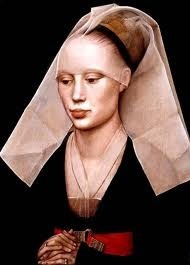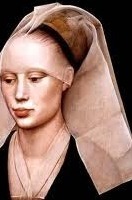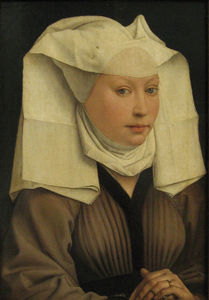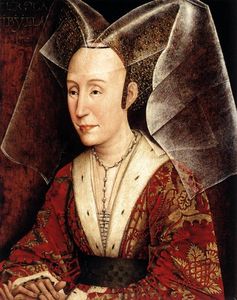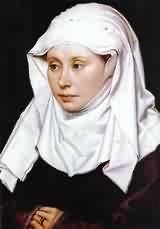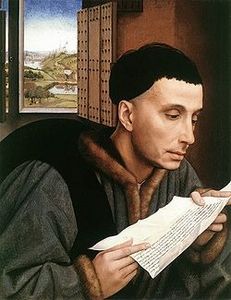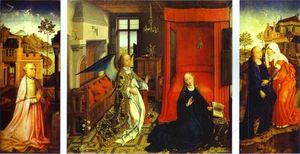Portrait of a Lady
- Date of Creation:
- circa 1460
- Height (cm):
- 34.00
- Length (cm):
- 25.50
- Medium:
- Oil
- Support:
- Wood
- Subject:
- Figure
- Art Movement:
- Renaissance
- Created by:
- Current Location:
- Washington, District of Columbia
- Displayed at:
- National Gallery of Art Washington
- Owner:
- Andrew W. Mellon
- Portrait of a Lady Page's Content
- Story / Theme
- Analysis
- Related Paintings
- Locations Through Time - Notable Sales
- Artist
- Bibliography
Portrait of a Lady Story / Theme
Like most of Rogier van der Weyden's portraits, the story behind this painting is as unknown as the woman portrayed. With her poised air of dignity and the fact that she could afford to commission a portrait as their only clues, scholars speculate that she is a member of the nobility.
Since the origin of this work is mysterious, so is van der Weyden's inspiration.
Portrait of a Lady Analysis
Composition:
This painting depicts a young woman, probably in her late teens or early twenties, gazing downward with her hands clasped tightly in front of her. Set against a dark background, she takes up the majority of the panel, situated at a three-quarter turn, with her dramatic creamy headdress drawing the viewer's eye toward her face.
The balance van der Weyden created with the interlocking triangles of her headdress and the top of her dress give the painting an abstract quality.
The artist has not omitted a single detail with regards to the subject's clothing. The woman's fashionable dress is buckled with a red belt and her veil is pinned carefully with silver pins. Even her two rings glisten from the bottom of the painting.
Use of light:
The painting's light source comes from above the sitter and casts a soft luminosity over her without creating large shadows or seeming too glaring.
Mood, tone and emotion:
Van der Weyden was a master at evoking the most subtle feelings from his subjects - a skill that didn't even become widely prized in portraiture until the later years of the Renaissance.
In Portrait of a Lady, van der Weyden has portrayed what appears to be this woman's consternated demureness - her pose is a society-approved one, but her eyes and pursed lips seem to divulge her discomfort with this fifteenth century feminine role she has been cast in.
Miscellaneous:
Van der Weyden, along with Robert Campin and Jan van Eyck, was among the first northern European painters to begin to portray middle and upper-class members in a more naturalistic setting, rather than an idealized form. This idealized form was nearly ubiquitous in the Middle Ages when portraiture was still a very young art genre and consisted of paintings in profile and an absence of emotion.
Portrait of a Lady Related Paintings
Portrait of a Lady Locations Through Time - Notable Sales
Although its earliest locations are uncertain, scholars believe that Portrait of a Lady passed through the hands of a number of Netherlandish princes during the 19th century before it was purchased by Duveen Brothers, Inc. of London, New York, and Paris in 1925.
In 1926, the Andrew W. Mellon Educational and Charitable Trust of Pittsburgh purchased the painting, and donated it as a gift in 1937 to the National Gallery of Art, Washington.
Portrait of a Lady Artist
Today Portrait of a Lady is regarded, with van der Weyden's other works, as an excellent representation of early Netherlandish portraiture. Van der Weyden is especially renowned for capturing the sitter's inner being and communicating this to viewers.
Rogier van der Weyden was seen as an innovative painter, with a fresh vision and acute sense of emotion - qualities often devoid in artists during a time when formulaic religious depictions were widespread.
Artists in his workshop reprinted and imitated his works for dissemination throughout Europe. What his contemporary imitators and students could not convincingly replicate, however, was the same subtlety and 'contempt for mere representation' that van der Weyden so effortlessly achieved.
Rogier van der Weyden was remembered during the 16th and 17th centuries as a well-respected artist and man and people still marveled at his unique interpretations and subtly emotive subjects.
During the 18th century, van der Weyden's name and works were all but forgotten after his most accessible and impressive work, Scenes of Justice, was destroyed in 1695. By the 19th century, however, art historians began the arduous task of piecing together the shreds of his biography and oeuvre, wading through confusing double-biographies, rediscovering manuscripts and records and attributing paintings.
Today, Rogier van der Weyden is regarded as one of the pre-eminent painters of the Early Netherlandish style, lauded for his introduction of masterfully subtle emotions. He enjoys a place in art history books alongside more well-known painters like Jan van Eyck, though his own accomplishments are unrivaled.
Portrait of a Lady Bibliography
For further insight into the works of Rogier van der Weyden, please refer to the following recommended sources.
• Campbell, Lorne. Van Der Weyden. Chaucer Press, 2004
• Campbell, L. & Van Der Stock, J. Rogier Van Der Weyden 1400-1464: Master of Passions. Waanders BV, Uitgeverij, 2009
• de Vos, Dirk. Rogier Van der Weyden: The Complete Works. Harry N. Abrams, 1999
• Kemperdick, Stephan. Rogier van der Weyden: 1399/1400-1464 (Masters of Netherlandish Art). H. F. Ullmann, 2008
• Pacht, Otto. Early Netherlandish Painting from Rogier van der Weyden to Gerard David. Harvey Miller Publishers, 1997
• Ridderbos, Bernhard, et al. Early Netherlandish Paintings: Rediscovery, Reception, and Research. J. Paul Getty Museum, 2005

